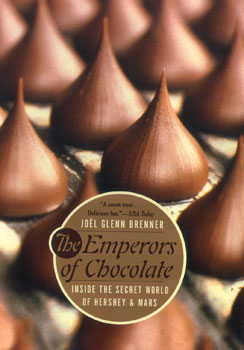Bookcase Location: MIDDLE SHELF – Permanent Collection
A more accurate subtitle would read ‘Behind the Lines in the Candy War Between Hershey’s & Mars’ because killing each other sweetly is what these dualing empires do. Akin to a David Lynch film, you know the car crash is coming, but you want to watch the accident anyway – in all its beautiful danger & delectable carnage. Full of intrigue, espionage, & double-dealings, this amounts to a business manual written as a novel. The Providence Journal nails it on the book jacket: a Euro style, century-old battle for hearts & stomachs reminiscent of Barbarians at the Gate, about an industry that’s anything but sweet.Brenner goes far inside to unmask Wonka, interviewing deep-throat / cut-throat covert operatives, off-the-cuff yet on-the-record, including a few right on the grounds of Mars’ headquarters located in McLean, VA – just down the block from the CIA.
The Emperors, of course, are Forrest Mars & Milton Hershey. Both built dreams &, as cagey businessmen, staggering fortunes. One could’ve amassed even greater wealth (drawing a modest salary & keeping profit margins to 3% instead of the industry norm 7%) while the other, a populist, gave all his away to charity. The former erected a global empire; the latter a utopian city.
Hershey’s outsells its foe in America; internationally Mars rules the battlefield… making each of their slogans ring true: ‘The Great American Chocolate Bar’ belongs to Hershey’s while ‘The Sweetest Things on Earth Come from Mars’.
Combatants to the bitter end, backchannels have nonetheless been opened between them, almost civil war-like, obscuring front lines & which side of the divide is who & where, beginning when Hershey’s originally supplied Mars of its essential raw material – cocoa.
In fact, the world’s most popular confection – M&Ms – inspired by chocolate lentils coated with sugar candy eaten in the Spanish Civil War, stands for the initials of Mars & R. Bruce Murrie, son of Hershey’s longtime president (& Milton’s best friend), William Murrie. M&Ms were christened during a brief charm offensive in 1940. The Federal Govt had severely rationed cocoa during that other war – WWII. Forrest Mars deceptively leveraged his relationships to tap Hershey’s exclusive supply. The story goes that Milton Hershey made a foolhardy speculation on the commodities market in the late 1930s & suffered a financial beating at the time. Once rationing took effect, however, his surplus stockpile appeared a latent stroke of genius. Throughout it all, Mars got what it wanted – continuous flow.
Payback came years later when a couple of Mars’ marketing executives were flipped & went to work on behalf of Hershey’s instead, implementing tactics learned & perfected at Mars based on greed, rivalry, secrecy, & paranoia. Candy Business 101 includes prominently displaying products right along the checkout counter at the height of a 10 year old; monopolizing retail racks with nothing but Hershey’s by paying ‘slotting fees’ (essentially bribery); promotional campaigns, & line extension. None of these spared Hershey’s from the market’s wrath in the ‘70s when the nickel candy bar collapsed due to another round of spiraling commodity costs. It was then forced to raise the price on a product that had also shrunk in size while Mars hummed along unaffected with its Milk Way bar which contained cheaper stuff, its main ingredient being air. As a safeguard, both companies now trade in hedge funds, futures contracts, & options. Mars even puts its proximity to the CIA to strategic use: satellite imagery & computer models measuring the combined effects of weather forecasts on the quality & size of upcoming harvests, economic trends, consumption patterns, political developments, & a myriad of other factors.
In the 21st century, the battle is fully joined, the war grinds on (including Mars’ $70 million “center of excellence” just 10 miles from Herhsey’s PA HQ), & nowadays Brenner might be staked out in the digital underground, ideally embedded to report the sequel.





